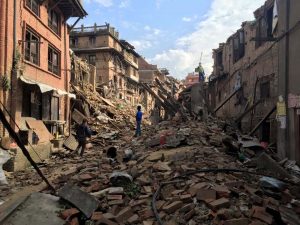
Nepali Timeline:
1996: Nepali Civil War begins
2001: Prince Dipendra assassinates nine royal family members
2002: King Gyanendra temporarily dissolves government
2008: Communist Party of Nepal-Maoist wins election, Nepal becomes the Federal Democratic Republic of Nepal
April 2015: Nepal Earthquake
Nepal was devastated by the Gorkha earthquake on April 25th, 2015. The 7.8 magnitude earthquake destroyed over 600,000 structures near and around Kathmandu, killed around 9,000 people, and injured thousands of Nepali people’s (Rafferty 2015). In a UN report, an estimated 8 million people were affected by the first earthquake, resulting aftershocks, avalanches, and landslides (Rafferty 2015). With a total population of only 30 million people, having over a quarter of the population having been negatively affected by the earthquake has put a tremendous amount of strain on social, economic, and environmental systems in Nepal.
The 2015 Gorkha earthquake is important to understand due to its impact on Nepali peoples. Firstly, this event has had lasting repercussions on the human security of Nepali peoples. Human security has been defined as,” safety from such chronic threats as hunger, disease and repression and protection from sudden and hurtful disruptions in the patterns of daily life (Johns 1). The 2015 earthquake in Nepal disrupted social systems by destroying Nepalese communities’ livelihoods. Homes and community buildings were lost in the hundreds of thousands, which has also had lasting impacts on an already struggling Nepali population. Around 42% of Nepalese peoples were expected to be below the poverty line before the strike of the 2015 earthquake, thus rendering its aftermath devastating for the already impoverished Nepalese peoples (Mathew and Upreti 141).
Second, natural disasters when paired with climate change can exacerbate their negative effects on people’s. Nepal was ranked 13th on the climate change risk atlas, so when a natural disaster such as the 2015 earthquake hits, an already vulnerable population is put under even greater stress (U.S. AID). Additionally, Nepal has up until very recently had incredibly unstable political systems (Mathew and Upreti 138), which was put under pressure by the aftermath of the 2015 earthquake. Food supplies, access to natural resources, and the overall stability of Nepali communities are expected to decline as the risks of climate change grows greater, so the importance of comprehending the effects of the 2015 Gorkha earthquake on the Nepalese peoples is incredibly important for this course.
Works Cited
Johns, Luke. “A critical evaluation of the concept of human security.” Retrieved August 18 (2014): 2015.
Matthew, Richard A., and Bishnu Raj Upreti. “Environmental Change and Human Security in Nepal.” Global Environmental Change and Human Security (2010): 137-154.
Rafferty, John P. “Nepal Earthquake of 2015.” Encyclopædia Britannica, Encyclopædia Britannica, Inc., 24 Apr. 2017.
